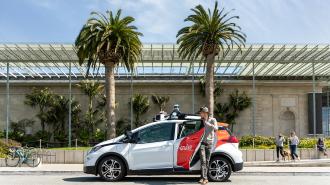General Motors subsidiary Cruise has just expanded its commercial robotaxi service to cover almost all of San Francisco — and more cities are just on the horizon.
Why it matters: While inclement weather, vehicle malfunctions, and other factors can contribute to car crashes, human error is the “critical reason” — the last event in the chain leading up to the accident — for 94% of crashes.
By replacing fallible drivers with (presumably) far less fallible autonomous vehicles (AVs), we could potentially slash the number of serious accidents on our roads and save countless lives.
“The next great thing could be fleets of robotaxis.”
Erik Gordon
Baby steps: Developing AVs that can drive everywhere under all conditions has proven more difficult than many thought it would be, though, and a personal AV that can only navigate a specific area would be a hard sell.
Rather than selling personal vehicles, many AV developers are now focused on building “robotaxis” that can be hailed like Ubers or Lyfts for autonomous rides in designated areas.
“Ride-hailing is a lousy business model with unhappy human drivers and urban mobility problems,” Erik Gordon, a professor at the University of Michigan who focuses on entrepreneurship and technology, told CNBC. “The next great thing could be fleets of robotaxis.”
“For the first time in eight years, the technology for AV is no longer the bottleneck.”
Kyle Vogt
On the rise: A handful of companies have been testing AVs on public roads and giving passengers free rides with a safety driver behind the wheel, but in June 2022, Cruise became just the second company (after Waymo) to launch a paid robotaxi service without a human backup driver.
At launch, the service area was limited to one corner of San Francisco, but on November 1, Cruise CEO Kyle Vogt announced that the company was ready to begin serving nearly the entire city.
“The new service area goes live for Cruisers today and likely to the public in a few weeks,” he tweeted. “@Cruise’s updated service area now includes the Mission, Marina, Presidio, etc.”
Beyond the Bay: Cruise appears confident that it’s worked out the kinks that have been holding back AVs and contributed to the failure of so many startups — in addition to expanding in San Francisco, it plans to begin service in Phoenix and Austin before the end of 2022.
“For the first time in eight years, the technology for AV is no longer the bottleneck,” Vogt told attendees at a Goldman Sachs conference in September. “We’re in a position to grow and to do it very quickly.”
We’d love to hear from you! If you have a comment about this article or if you have a tip for a future Freethink story, please email us at tips@freethink.com.






